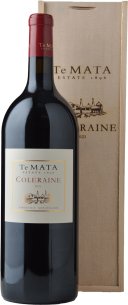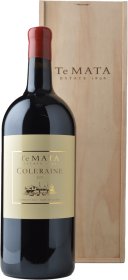Shangri-La Ao Yun Cabernet Franc Cabernet
Luring luxury connoisseurs from around the globe, this Chinese red is making waves internationally for being the first legitimately competitive high-end wine to come out of the countrys developing wine production industry. Its production is a long, complex story of cooperation between the CEO of Moët Hennessy, Australian enologist Tony Jordan, the Chinese government and Tibetan farmers - and its yielded something spectacular. The name Ao Yun means roaming above the clouds - and the name is apt, as the vineyards which produce it rise up to 2,600 metres at the foot of a sacred mountain in Yunnan province, not far from the famed city of Shangri-La on the fringe of the Himalayas. This spellbinding terrain has produced a wine of powerful flavour, complex spice, and a silky texture with tannin to spare and massive aging potential. Dont miss your chance to own a piece of wine-making history from a nation with the potential to become a powerhouse.
Abreu Cappella Cabernet Sauvignon
Chateau Ducru-Beaucaillou 2me cru classe
Taking its name from its uniquely rocky terroir (beau caillou translates as beautiful stones), and Bertrand Ducru who purchased the estate in 1795, what we know today as Chateau Ducru Beaucaillou as a wine producing estate, has history stretches back to the 13th century. Owned today by The Borie family (who have long-standing roots of their own in Bordeaux), the Chateau is, according to many, producing the best wines in their history at this very moment. The 2016 vintage has already been hailed as yet another monumental success for the winery with Antonio Galloni praising it as simply magnificent.
Te Mata Estate Coleraine Cabernet Sauvignon Merlot Cabernet Franc
TE MATA ESTATE Coleraine. Cepage may include Cabernet Sauvignon, Merlot, and Cabernet Franc. Hawkes Bay, New Zealand
Chateau Figeac 1er grand cru classe (B)
While a fair share of Bordeaux vineyards can claim significant historical pedigree, few would be able to touch Chateau Figeac - it is one of a select few St Emilion vineyards to have been continuously occupied for over 2,000 years! The estate dates back to the second century when even the ancient Romans who occupied the area were aware of its outstanding terroir. One figure dominates the Chateau’s modern era, and that is Thierry Manoncourt who ran the property from 1947 until his death in 2010, just shy of his 93rd birthday. Under his leadership, the Chateau was the first major Right Bank estate to embrace modern techniques such as temperature controlled, stainless steel vats. The traditional-styled Bordeaux has, understandably, gone through a wide range of iterations in its 2,000-plus year history - yet it still manages to surprise and delight. The 2016 earned rave reviews from critics, with Jancis Robinson hailing it as a wine of which “...the Manoncourt family should be very proud.”
Chateau Palmer 3me cru classe
Regarded a Super Second (but technically a 3me growth), Palmer is capable of producing wines that equal or even outstrip the quality of its famous Premier cru neighbour, Ch. Margaux. Named for the wealthy English military man who bought the estate in the early 19th century, Palmer is now majority owned by the Mahler Besse and Sichel families - famous Bordeaux negociants. Many of the best plots on the property were purchased after the Classification of 1855, explaining in part why Palmer did not warrant higher standing at that time. Certainly today there is no question that the wine is among Bordeauxs best. The estate also makes a separate second label - named Alter Ego - which is made from similarly high quality fruit but treated differently in the winery with the aim of producing a counterpoint in style to the First wine.
Chateau Montrose 2me cru classe
Chateau Montrose is a second Grand Cru Classé estate in St-Estephe and is considered one of the leading wine properties of the appellation. Located in the eastern half of the appellation just 800 metres from the Gironde estuary, the propertys proximity to the water provides a unique micro-climate that protects the vines from frost. The Grand Vin is a blend of Cabernet Sauvignon, Merlot and Cabernet Franc, that appears very powerful and austere in its youth, with a backbone of firm tannins that provides exceptional longevity.
Chateau Lynch-Bages 5me cru classe
Lynch-Bages is an iconic fifth growth of Pauillac and has the distinction of having produced the only wine that has ever been sent into space. Established in the early 1700s, the wine was labelled Chateau Jurine Bages at the time of the 1855 classification, later renamed in recognition of earlier owners the Lynch family. Jean-Charles Cazes purchased the property in the 1930s, later passing the management of the estate to his grandson Jean-Michel Cazes who modernised the winery and was a prolific spruiker of not just his own wines, but those of all Bordeaux throughout the 70s and beyond. Now managed by the next generation, (another Jean-Charles) Lynch-Bages continues to produce Cabernet Sauvignon-led wines of great concentration, offering ripe cassis and enviable cellaring potential.
Chateau Mouton-Rothschild 1er cru classe
One of the very greatest estates of Bordeaux, Château Mouton Rothschild is in the commune of Pauillac in the Haut-Medoc, 50km north-west of the city of Bordeaux. Its Chateau wine or grand vin is among the worlds most highly-rated and expensive. Excluded from the highest rank (Premier Cru or First Growth) of the famous Bordeaux Classification of 1855, Mouton was finally promoted in 1973 after decades of lobbying by Baron Philippe de Rothschild, who ran the estate from 1922 until his death in 1988. Mouton was first in the region to bottle at the estate, rather than shipping its wine to merchants for bottling elsewhere. Since 1924 artists including Braque, Dali, Picasso, Henry Moore, Miro, Chagall, Kandinsky, Andy Warhol, Francis Bacon, David Hockney and Lucian Freud have been commissioned to produce label images. Mouton, uniquely among the First Growths, remains in the hands of the same family as it was at the time of the 1855 Classification. The vineyards are on slopes with gravel-based soils leading down to the Gironde estuary and total 75ha 80% Cabernet Sauvignon, 16% Merlot, 3% Cabernet Franc and 1% Petit Verdot. The Chateau wine is (unusually) fermented in large oak vats and then matured in new oak barrels for between 19 and 22 months. Total production of the grand vin is 20,000 dozen or less. There is a second wine, Le Petit Mouton, established in 1993. The grand vin is noted for its flamboyance exotic, powerful aromas of cassis, minerals, tobacco leaf and graphite, an opulent palate and impressive length of flavour.
Chateau Leoville-Las-Cases 2me cru classe
With one of the longest and most pedigreed histories in the Medoc region, Chateau Leoville-Las-Cases has passed through the hands of some of Frances most notable and wealthiest noble families, culminating in the Las Cases family - the final royal family to hold title to the Chateau. Up until the French Revolution, after which large portions of it were sold off, it was one of the largest vineyards in Bordeaux. Today, the estate remains family owned by the Delons, of which brother Jean Hubert and sister Genevieve manage proceedings. Famed for producing a wine of structure, power, and traditional style, the 2016 vintage has earned outstandingly high praise, including a score of 100 from Andrew Caillared and a 19/20 from Jancis Robinson who praised its extraordinary vitality and energy and proclaimed it glorious to taste now.




























